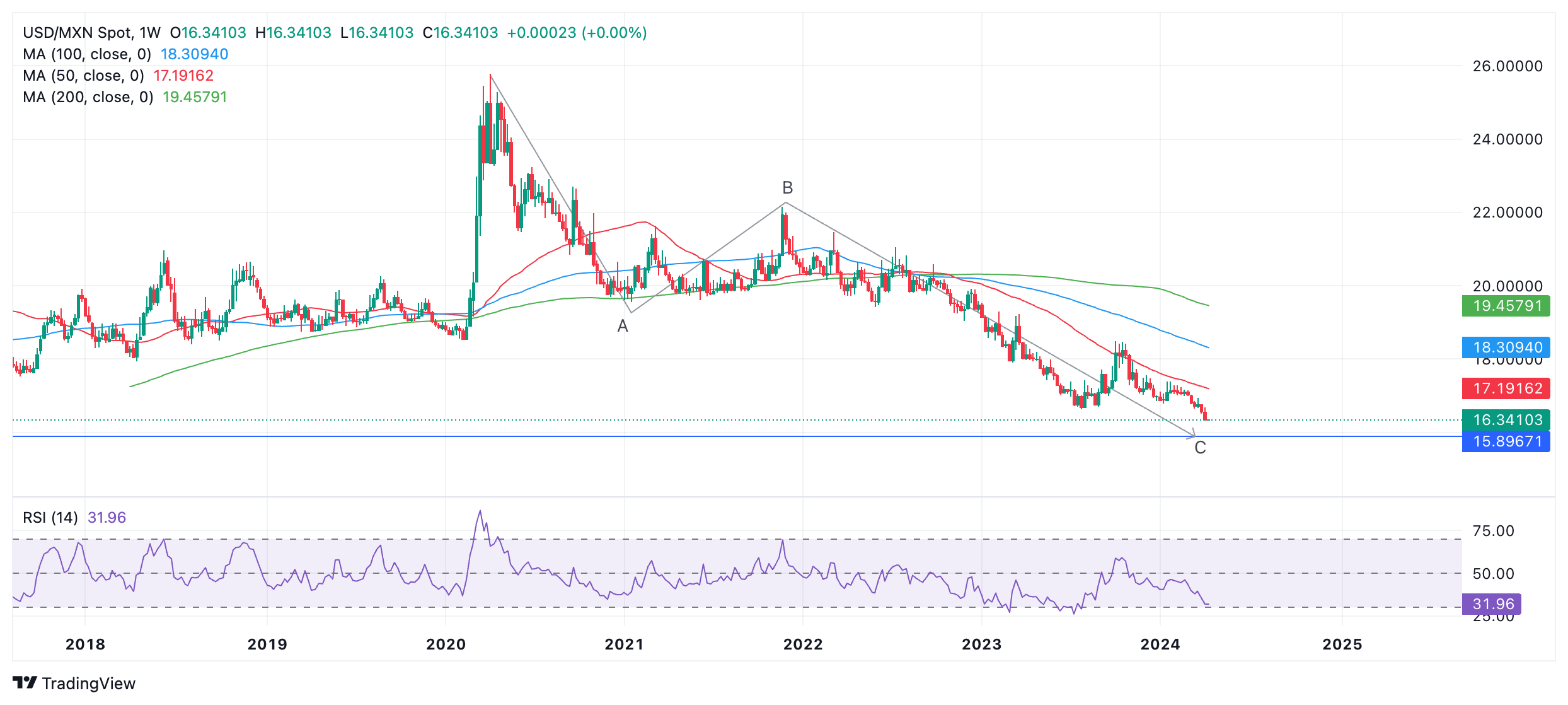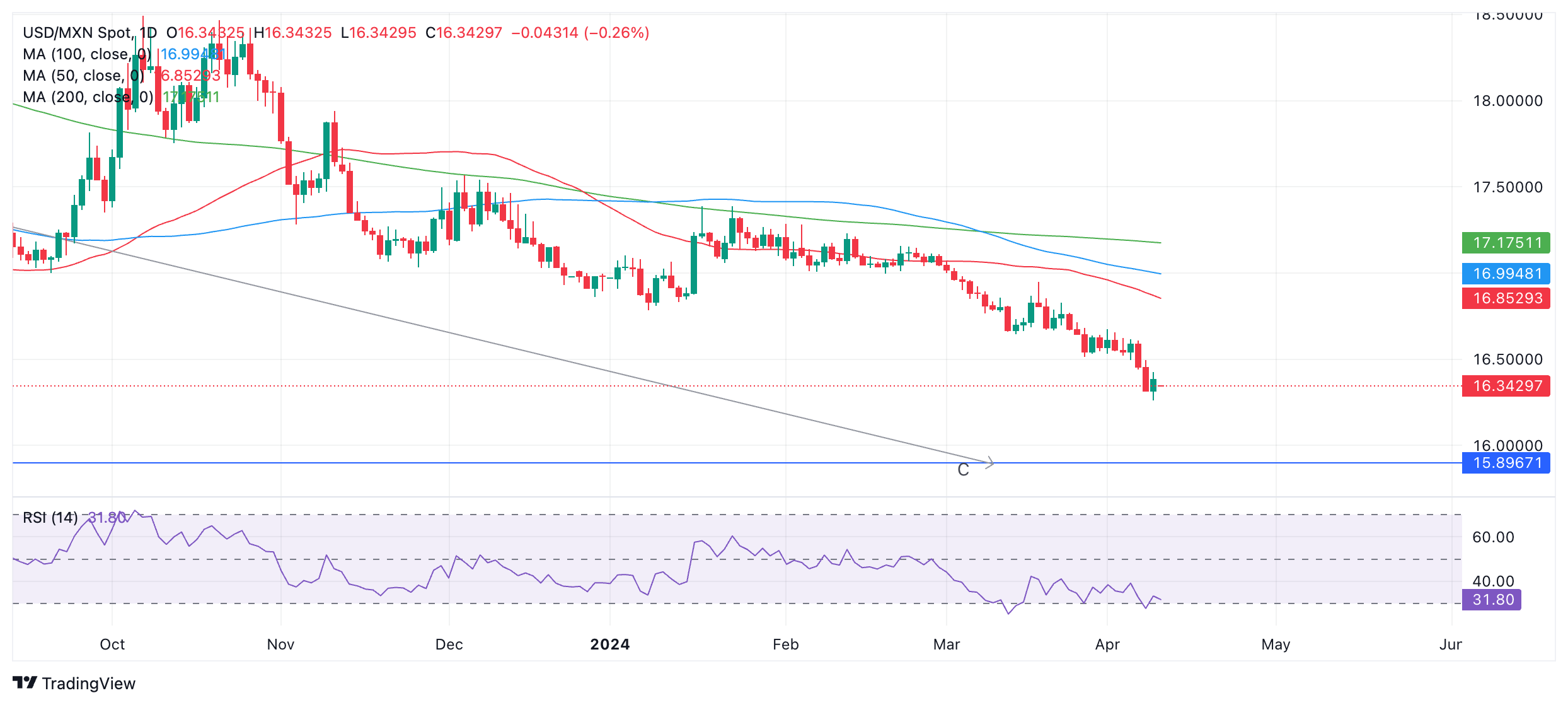- The Mexican peso has resumed its upward trend despite lower-than-expected March inflation data.
- The slowdown in price pressures was not substantial enough to change the overall outlook for monetary policy.
- Interest rates, one of the main drivers of the foreign exchange market, are likely to remain high in Mexico, which will support the Peso in the future.
The Mexican Peso (MXN) is trading higher in most pairs this Wednesday, in line with the currency's long-term trend. It has already undone the losses of the day before, when March inflation data, more moderate than expected, marginally raised the possibility of a reduction in interest rates by the Bank of Mexico (Banxico).
The Mexican peso continues to rise due to the divergence of interest rates
The Mexican peso has developed a long-term upward trend thanks to relatively high interest rates in Mexico, which help attract foreign capital inflows.
Although Banxico cut its overnight interbank interest rate from 11.25% to 11.00% in March, it did so without committing to further rate cuts.
However, the minutes of the meeting revealed that the balance of risks remains tilted in favor of inflation remaining stubbornly high going forward. This will likely force Banxico to keep interest rates at a relatively high level, which will continue to support the MXN.
This week, industrial production and retail sales data for Mexico will be published, on Thursday and Friday respectively. None of them are likely to move the Mexican peso, but they will provide more information about the behavior of the economy.
The macroeconomic data, above expectations, will likely strengthen the Mexican peso. Banxico stated that, despite the rise in interest rates, the economy continues to show a high degree of “dynamism” and resilience, and the data supports that view. This will likely mean that the central bank will keep interest rates at their relatively high level for longer.
US CPI data could impact USD/MXN
The Mexican Peso pair against the US Dollar (USD/MXN) could also see increased volatility on Wednesday with the release of US Consumer Price Index data at 12:30 GMT, during the US session.
Economists expect overall prices in the U.S. to have risen 3.4% annually in March and 3.7% annually for the underlying measure, which excludes volatile food and energy prices.
A higher than expected result would support USD/MXN and the opposite would occur in case of a lower than expected result.
Technical analysis: USD/MXN extends bearish trend
USD/MXN is in a long-term downtrend that began in April 2020, after the pair peaked at 25.76, and has since fallen as low as 16.30. Considering the old adage that “the trend is your friend,” it is likely to continue downward.
The pair is likely displaying a three-wave price pattern, called a “measured move.” These patterns are composed of a wave A, B and C, with wave C extending to a similar length to wave A, or a 0.618 Fibonacci ratio of A.
USD/MXN Weekly Chart

If this is the case, the price has almost reached the point where C will equal A, calculated at 15.89.
It has also already surpassed the conservative target for the end of C at the 0.618 Fibonacci extension of A (at 18.24).
Once the pattern is completed, the market usually reverses its trend or undergoes a substantial correction.
The Relative Strength Index (RSI) is converging noticeably with the price, a sign that the downtrend could be losing momentum. In 2024, USD/MXN has moved below the 2023 lows, but the RSI has not done the same. This lack of correlation is a bullish sign. It could lead to an upward correction.
However, prices have not yet reacted, so bullish expectations remain speculative and unconfirmed.
USD/MXN Daily Chart

The daily chart shows the most recent activity in greater detail. It is worth highlighting the RSI, which has left the oversold zone. This recommends that short position holders trading in the intermediate term (3-6 months) close their short bets and open long ones.
Coupled with the bullish convergence on the weekly chart, this could indicate that USD/MXN is about to start an upward correction.
However, the absence of other bullish price signals, such as a bullish reversal candlestick pattern, for example, suggests that bulls should be cautious before expecting further upside.
Furthermore, given the strong downtrend, the RSI momentum indicator signal is likely to be less reliable, as the RSI does not work as effectively in strongly trending markets.
Frequently Asked Questions about the Mexican Peso
What is MXN?
The Mexican Peso is the legal tender of Mexico. The MXN is the most traded currency in Latin America and the third most traded on the American continent. The Mexican Peso is the first currency in the world to use the $ sign, prior to the later use of the Dollar. The Mexican Peso or MXN is divided into 100 cents.
What is Banxico and how does it influence the MXN?
Banxico is the Bank of Mexico, the country's central bank. Created in 1925, it provides the national currency, the MXN, and its priority objective is to preserve its value over time. In addition, the Bank of Mexico manages the country's international reserves, acts as a lender of last resort to the banks and advises the government economically and financially. Banxico uses the tools and techniques of monetary policy to meet its objective.
How does inflation impact the MXN?
When inflation is high, the value of the Mexican Peso (MXN) tends to decrease. This implies an increase in the cost of living for Mexicans that affects their ability to invest and save. At a general level, inflation affects the Mexican economy because Mexico imports a significant amount of final consumption products, such as gas, fuel, food, clothing, etc., and a large amount of production inputs. On the other hand, the higher the inflation and debt, the less attractive the country is for investors.
How does the Dollar influence the Mexican Peso (MXN)?
The exchange rate between the USD and the MXN affects imports and exports between the United States and Mexico, and may affect demand and trade flows. The price of the Dollar against the Mexican Peso is affected by factors such as monetary policy, interest rates, the consumer price index, economic growth and some geopolitical decisions.
How does the Fed's monetary policy affect Mexico?
The exchange rate between the USD and the MXN affects imports and exports between the United States and Mexico, and may affect demand and trade flows. The price of the Dollar against the Mexican Peso is affected by factors such as monetary policy, interest rates, the consumer price index, economic growth and some geopolitical decisions.
Source: Fx Street
I am Joshua Winder, a senior-level journalist and editor at World Stock Market. I specialize in covering news related to the stock market and economic trends. With more than 8 years of experience in this field, I have become an expert in financial reporting.







